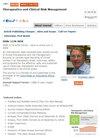脑外伤患者急性肾损伤的分类和回归树预测模型
IF 2.8
3区 医学
Q1 Pharmacology, Toxicology and Pharmaceutics
引用次数: 0
摘要
背景:急性肾损伤(AKI)是创伤性脑损伤(TBI)住院患者的常见病,会增加不良预后的风险。我们设计了这项研究,旨在开发一种基于决策树的可视化便捷模型,用于预测创伤性脑损伤患者的 AKI:方法:共纳入2015年1月至2019年6月期间华西医院急诊科收治的376例TBI患者。将人口统计学信息、入院时的生命体征、实验室检查结果、放射学体征、手术方案和药物作为变量记录。根据 "肾脏疾病改善全球结局 "标准,入院后第二天即确认为 AKI。我们分别使用最小绝对收缩和选择算子(LASSO)回归和分类回归树(CART)构建了两个 AKI 预测模型。我们绘制了这两个预测模型的接收者操作特征曲线(ROC),并计算了 ROC 曲线下面积(AUC),以比较它们的预测准确性:结果:创伤性脑损伤患者入院后第二天的AKI发生率为10.4%。拉索回归确定了五个有力的 AKI 预测因素:葡萄糖、血清肌酐、胱抑素 C、血清尿酸和新鲜冰冻血浆输注。CART 分析显示,就决策树模型的特征重要性而言,葡萄糖、血清尿酸和胱抑素 C 位居前三位。决策树预测模型的 AUC 值为 0.892,高于 LASSO 回归模型的 0.854,但差异无统计学意义:结论:决策树模型对预测创伤性脑损伤患者的 AKI 很有价值。结论:决策树模型对预测创伤性脑损伤患者的 AKI 很有价值,这种基于树的流程图便于医生识别 AKI 高风险的创伤性脑损伤患者,并提示他们制定合适的治疗策略。本文章由计算机程序翻译,如有差异,请以英文原文为准。
Classification and Regression Tree Predictive Model for Acute Kidney Injury in Traumatic Brain Injury Patients
Background: Acute kidney injury (AKI) is prevalent in hospitalized patients with traumatic brain injury (TBI), and increases the risk of poor outcomes. We designed this study to develop a visual and convenient decision-tree-based model for predicting AKI in TBI patients.
Methods: A total of 376 patients admitted to the emergency department of the West China Hospital for TBI between January 2015 and June 2019 were included. Demographic information, vital signs on admission, laboratory test results, radiological signs, surgical options, and medications were recorded as variables. AKI was confirmed since the second day after admission, based on the Kidney Disease Improving Global Outcomes criteria. We constructed two predictive models for AKI using least absolute shrinkage and selection operator (LASSO) regression and classification and regression tree (CART), respectively. Receiver operating characteristic (ROC) curves of these two predictive models were drawn, and the area under the ROC curve (AUC) was calculated to compare their predictive accuracy.
Results: The incidence of AKI on the second day after admission was 10.4% among patients with TBI. Lasso regression identified five potent predictive factors for AKI: glucose, serum creatinine, cystatin C, serum uric acid, and fresh frozen plasma transfusions. The CART analysis showed that glucose, serum uric acid, and cystatin C ranked among the top three in terms of the feature importance of the decision tree model. The AUC value of the decision-tree predictive model was 0.892, which was higher than the 0.854 of the LASSO regression model, although the difference was not statistically significant.
Conclusion: The decision tree model is valuable for predicting AKI among patients with TBI. This tree-based flowchart is convenient for physicians to identify patients with TBI who are at high risk of AKI and prompts them to develop suitable therapeutic strategies.
Methods: A total of 376 patients admitted to the emergency department of the West China Hospital for TBI between January 2015 and June 2019 were included. Demographic information, vital signs on admission, laboratory test results, radiological signs, surgical options, and medications were recorded as variables. AKI was confirmed since the second day after admission, based on the Kidney Disease Improving Global Outcomes criteria. We constructed two predictive models for AKI using least absolute shrinkage and selection operator (LASSO) regression and classification and regression tree (CART), respectively. Receiver operating characteristic (ROC) curves of these two predictive models were drawn, and the area under the ROC curve (AUC) was calculated to compare their predictive accuracy.
Results: The incidence of AKI on the second day after admission was 10.4% among patients with TBI. Lasso regression identified five potent predictive factors for AKI: glucose, serum creatinine, cystatin C, serum uric acid, and fresh frozen plasma transfusions. The CART analysis showed that glucose, serum uric acid, and cystatin C ranked among the top three in terms of the feature importance of the decision tree model. The AUC value of the decision-tree predictive model was 0.892, which was higher than the 0.854 of the LASSO regression model, although the difference was not statistically significant.
Conclusion: The decision tree model is valuable for predicting AKI among patients with TBI. This tree-based flowchart is convenient for physicians to identify patients with TBI who are at high risk of AKI and prompts them to develop suitable therapeutic strategies.
求助全文
通过发布文献求助,成功后即可免费获取论文全文。
去求助
来源期刊

Therapeutics and Clinical Risk Management
HEALTH CARE SCIENCES & SERVICES-
CiteScore
5.30
自引率
3.60%
发文量
139
审稿时长
16 weeks
期刊介绍:
Therapeutics and Clinical Risk Management is an international, peer-reviewed journal of clinical therapeutics and risk management, focusing on concise rapid reporting of clinical studies in all therapeutic areas, outcomes, safety, and programs for the effective, safe, and sustained use of medicines, therapeutic and surgical interventions in all clinical areas.
The journal welcomes submissions covering original research, clinical and epidemiological studies, reviews, guidelines, expert opinion and commentary. The journal will consider case reports but only if they make a valuable and original contribution to the literature.
As of 18th March 2019, Therapeutics and Clinical Risk Management will no longer consider meta-analyses for publication.
The journal does not accept study protocols, animal-based or cell line-based studies.
 求助内容:
求助内容: 应助结果提醒方式:
应助结果提醒方式:


